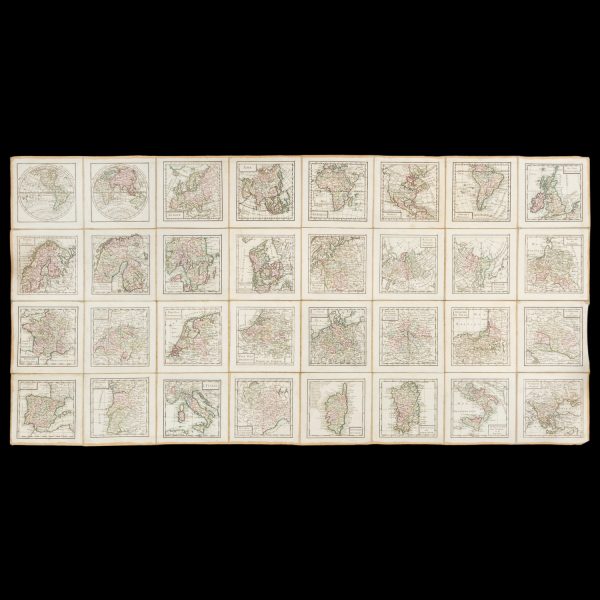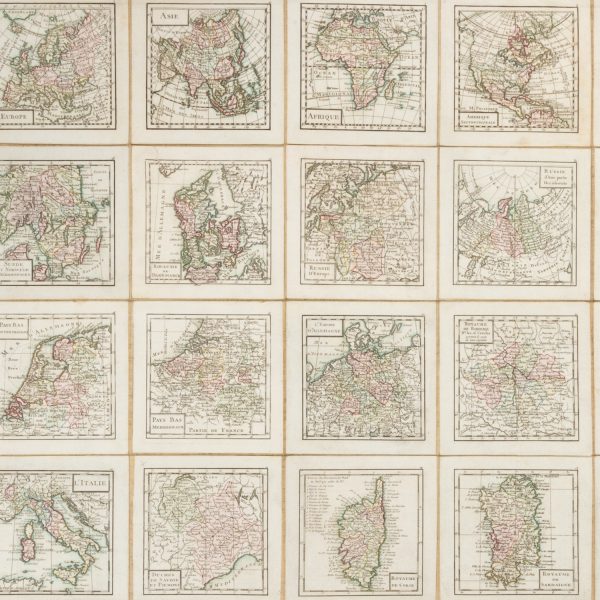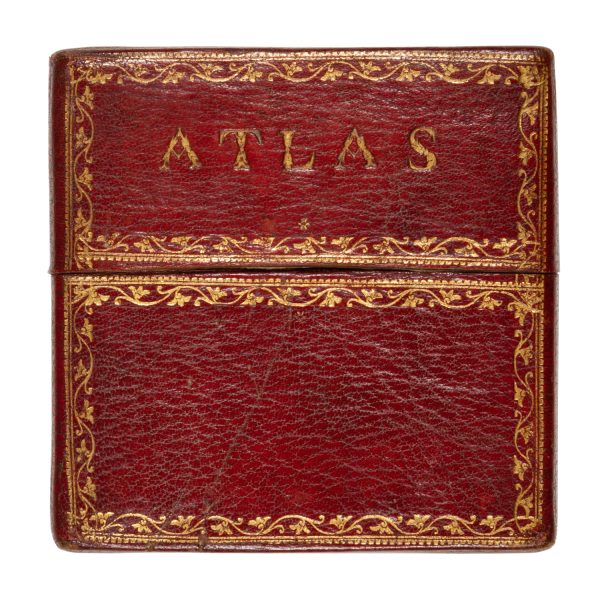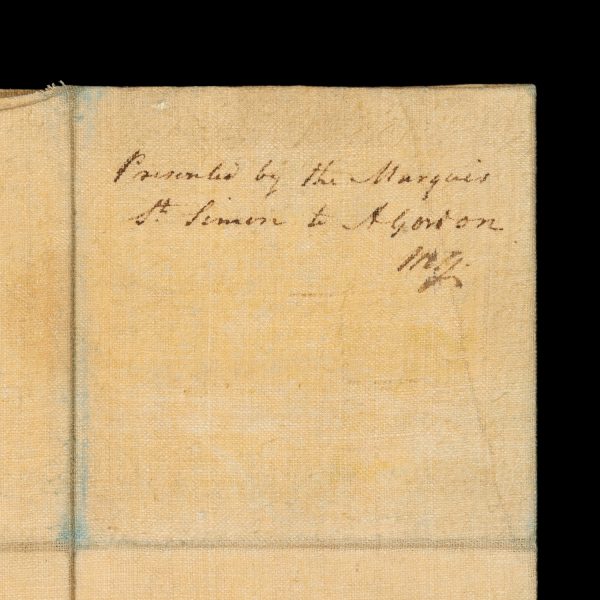# 42554
[DESNOS, Louis-Charles]
[CASED POCKET ATLAS; REVOLUTIONARY WAR]. [Almanach géographique ou petit atlas élémentaire …]
$14,500.00 AUD
[Paris : Desnos, circa 1771]. Thirty-two copperplate engraved maps, each measuring 95 x 95 mm (image) and 115 x 115 mm (sheet), numbering in the upper right corner of each map; laid on linen, overall measurements 470 x 940 mm; inscribed verso Presented by the Marquis St. Simon to A. Gordon, with the initials M. G. (another Gordon family member?) below, and with another inscription crossed out; housed in a red morocco presentation case with gilt-tooled decoration and title ATLAS, 125 x 125 mm, lined with blue paper and silk.
A rare configuration – possibly unique – of Desnos’ Almanach géographique ou petit atlas élémentaire, dissected and laid on linen, in a fully contemporary presentation case. An inscription records that the cased atlas was presented – presumably to its second owner – by Claude Anne de Rouvroy, Marquis de Saint-Simon-Montbléru (1743-1819), a highly significant figure in the American Revolutionary War.
The Marquis de Saint-Simon sailed for the Caribbean in 1779 as a colonel in the Touraine regiment. In 1781 he arrived at Jamestown, Virginia in command of 3500 French soldiers, where he joined forces with a smaller American army under Lafayette. Between them, Saint-Simon and Lafayette conducted the siege of Yorktown, during which Saint-Simon’s force succeeded in preventing Cornwallis and his troops from escaping northwards along the road to Williamsburg. Although he was badly wounded in the leg, Saint-Simon refused to leave the lines until the British surrendered, and insisted on mounting his horse in order to take part in the surrender ceremony. Saint-Simon was personally thanked by Washington for his contribution to the American cause in a letter written just before his return to the West Indies (Library of Congress, George Washington Papers, Series 4, General Correspondence: George Washington to Saint-Simon, October 24, 1781). He was also made one of the original members of the Society of the Cincinnati, the private patriotic organisation founded by Washington. In 2018, the American Revolution Institute of the Society of the Cincinnati in Washington, D.C. announced its acquisition of a portrait of Saint-Simon painted between 1815 and 1818 by the Spanish artist Vicente Lopez. It is the only portrait in American institutional collections of this lesser-known yet important participant in the Revolutionary War.
Louis-Charles Desnos was one of the most prolific and influential map and globemakers of his age, at a time when Paris was the leading centre of map production in Europe. Desnos married the widow of Nicolas Hardy, son of Jacques Hardy, a globemaker active during the period 1738-1745. Desnos acquired Hardy’s inventory and tools and expanded the company, also acquiring the inventories of the Jaillot family and of Nicolas de Fer. Desnos would be appointed Royal Globemaker to King Christian VII of Denmark, and continued publishing throughout the late eighteenth century.
Desnos first published his miniature atlas in 1770; it would be reissued in two volumes later the same year, and again in 1771 with the addition of plate numbers to the maps, as in the present example. The maps are titled: Hemisphere Orientale; Hemisphere Occidentale; Europe; Asie; Afrique; Amerique Septentrionale; Amerique Meridionale; Royaume de France; La Suisse divisée en ses xiii cantons et ses allies; L’Italie; Duchés de Savoye et Piemont; Le Royaume de Naple et de Sicile; Royaume de Sardaigne; Royaume de Corse; Espagne et Portugal; Royaume de Portugal; Les Isles Britanniques; Pays Bas septentrionaux; Pays Bas meridionaux; L’Empire d’Allemagne; Royaume de Boheme na. les 16 cercles portent le nom de leurs capitales; Royaume de Prusse; Le Royaume de Hongrie; Royaume de Pologne; Royaume de Danemarck; Suede et Norwege; Suede et Norwege septentrionales; Suede et Norwege meridionales; Russie d’Europe; Turquie d’Europe; Russie d’Asie partie occidentale; Russie d’Asie partie orientale.
We can locate no other examples which have been laid on linen and specially housed in a morocco case. The present example, originally owned by a significant figure in the Revolutionary War, is possibly a uniquely prepared copy with a purpose-made, sturdy leather case, portable and eminently suited to being carried in the pocket of a military coat.










